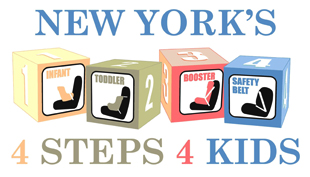On This Page
 The Child Passenger Safety program of the Monroe County Office of Traffic Safety promotes the proper use of child safety seats. Our office is pleased to announce that we will be conducting a fitting station to educate adults on how to properly install a child safety seat in their personal vehicle. Parents and caregivers are able to make an appointment with our office to have their child safety seat installation checked. Dates and times can be found at the link below including a listing of all the fitting stations available at other Monroe County agencies.
The Child Passenger Safety program of the Monroe County Office of Traffic Safety promotes the proper use of child safety seats. Our office is pleased to announce that we will be conducting a fitting station to educate adults on how to properly install a child safety seat in their personal vehicle. Parents and caregivers are able to make an appointment with our office to have their child safety seat installation checked. Dates and times can be found at the link below including a listing of all the fitting stations available at other Monroe County agencies.
Our office also provides training for technicians to conduct safety seat fitting stations and public checkpoints. The National Highway Traffic Safety Administration’s “Standardized Child Passenger Safety Technician Training Course” will be offered in Monroe County. Please contact our office for the dates and times to register for this course.
Contact our office at (585)753-3018 for more information.
Q. What does "child restraint system" mean?
A child restraint system is any device, used in conjunction with safety belts, designed for use in a motor vehicle to restrain, seat, or position children and meets the Federal Motor Vehicle Safety Standards set forth in 49 C.F.R. 571.213.
Q. What are they?
It may be a child safety seat or harness/vest or booster seat. (The vehicle's safety belts are not a child restraint system.)
Q. What does "appropriate" mean?
An appropriate child restraint system is one that meets the child's height, weight, and size according to the manufacturer's recommendation for that restraint system.
Q. What is the fine for a violation?
Fines will range from $25 to $100 for violations.
Q. What is the occupant restraint law for children from birth to their 2nd birthday?
Infants and toddlers should ride in a rear-facing car seat for as long as possible, but at least until the age of 2 (NYS Law). If a child outgrows the weight or height limit of the seat, then a convertible or all-in-one car seat should be used in the rear-facing position until the child outgrows the weight or height limit set by the car seat manufacturer.
Q. What is the occupant restraint law for children who are under the age of 4?
Children under the age of 4 are required to be restrained in a federally approved child safety seat when riding in a motor vehicle. If the weight of a child under the age of 4 exceeds 40 pounds, the child may be restrained in an appropriate child restraint system, allowing the child to use a booster seat.
Q. Does the law apply to school buses?
No. However, children under the age of 4 must be restrained in a federally approved child safety seat when riding in a school bus. Liveries, taxis, and public transportation buses are exempt from the occupant restraint law.
Q. Once a child turns 4 years old, should he or she be in a booster seat?
Not necessarily. Choose the restraint system that will fit your child's weight and size. Read the manufacturer's instructions and recommendations for that particular seat. For maximum protection, keep a child in a forward-facing child safety seat with full internal harness until they reach the manufacturer's recommendations for upper size limits. The harness provides upper body, head, and neck protection.
Q. Who should use a booster seat?
The next step of children who have outgrown a forward-facing child safety seat is a booster seat, usually when a child weighs more than 40 pounds or grows more than 40 inches in height.
Q. What type of booster seat should you use?
There are two major types of belt-positioning booster seats:
- Backless or low-back booster seats are used in vehicles with a high seat back in which the child's head can be supported by the vehicle seat back or head restraint.
- High-back booster seats are used in vehicles with a low seat back where there is no vehicle seat back or head restraint to support the child's head and neck.
Booster seats must be used with both the lap and shoulder belt. A booster seat should never be used with a lap belt only.













